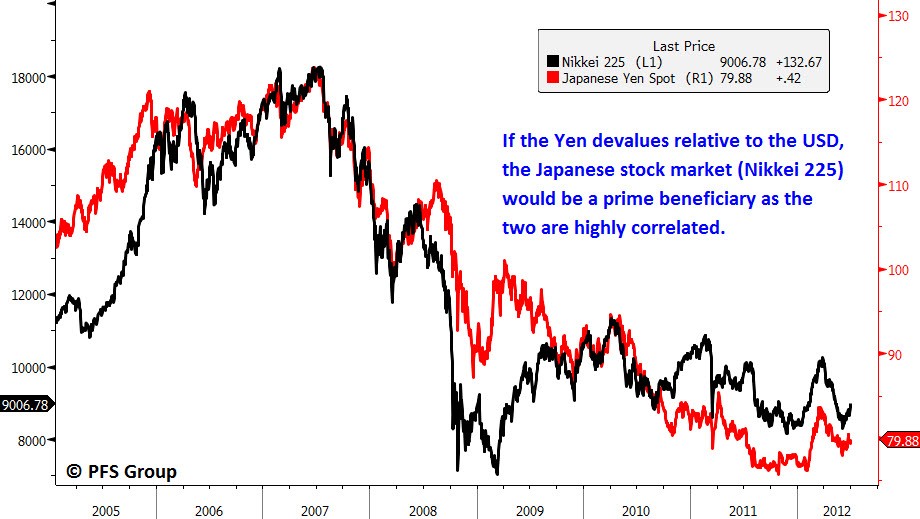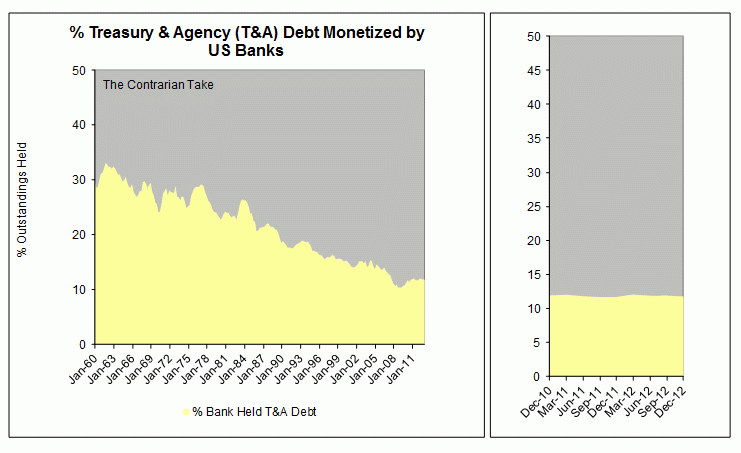Debt Monetization A Nearsighted Government Policy
Post on: 29 Апрель, 2015 No Comment

Added by alberto1 on November 18, 2013.
The public debate regarding debt and debt monetization is as old as the Republic. James Madison called debt a curse on the public, and first Treasury Secretary Alexander Hamilton called it a blessing provided that the debt wasnt excessively large. The modern day debt monetization term emanated from the Treasurys cost of financing World War IIs debt through increased bond issues.
Historically, the Treasury Department has determined the amount of debt and maturities issued. In this capacity, it has full control over monetary policy. defined as the supply of money and credit. The Federal Reserve was the distributor of all debt to the public and supported debt prices through sales of bonds, notes and bills. A collision occurred between the two agencies due to failing to finance the war debt in a timely manner.
The 1951 Treasury-Fed Accord settled the question of who controls the Feds balance sheet by reversing roles. The Fed would control monetary policy by supporting debt prices without control over any debt it holds, and would buy what the public doesnt want, while the Treasury would focus on the amount of issuance and categorical maturities. (Learn about the tools the Fed uses to influence interest rates and general economic conditions, read Formulating Monetary Policy .)
Monetary Policy
Since 1951 monetary policy has been controlled through the Feds Open Market Operations with aTreasuries -only policy. This separated the Fed from fiscal policy and credit allocation, and allowed for true independence. It also freed the Fed from monetizing debt for fiscal policy purposes and prevented collusion, such as agreements to peg interest rates directly to Treasury issues. Credit policy was also separated and limited to Treasury, defined as bailing out institutions, sterilizing foreign exchange operations and transferring Fed assets to Treasury for deficit reduction. The Treasury Secretary and the comptroller of the currency were removed from the Federal Reserve Board so that policy decisions were separate from fiscal policy. Today 12 Federal Reserve Bank Governors and the Chairman of the Fed make up the Federal Open Market Committee that sets interest rate and money supply policies.
Effects of Monetizing Debt
Monetizing debt leads to an increase in money growth in relation to interest rates, but not necessarily to money growth in relation to government purchases or open market operations. Monetizing debt occurs when changes in debt produce changes in interest rates. Yet money growth alone is not a monetizing of the debt because money growth ebbs and flows through contraction and expansion cycles over the years without a change in interest rates.
Suppose a wash sale occurred where all debt issued was sold with no monetization. This is fiscal policy objectives completed. Fiscal policy is the tax and spending policy of current presidential administration. What if money growth was equal to debt without monetization? Money growth is found in M1 , M2 and M3. M1 is money in circulation, M2 is M1 plus savings and time deposits under $100,000 and M3 is M2 plus large time deposits over $100,000. So, open market operations is the issuance of debt replaced with money. (To read about the different money categories, refer to What Is Money? )
Monetizing the debt can also be characterized as money growth in excess of the federal debt or no money growth in relation to debt. This last example is called the liquidity effect, where low money growth leads to low interest rates. Either will change the velocity of money. defined as how fast money circulates. Usually the target is a debt growth equal to velocity. This allows the system to be in sync.
Why Does the Fed Monetize Debt?
A better way to understand this relationship is to ask: what are the Feds targets? Do they target growth to velocity, money growth to employment, as was once the case, money growth equaled to the present supply of money, interest rate targets or inflation. Targets to inflation have not only proven to be disastrous, but studies show negative statistical relationships forcing an out of sync growth-to-debt relationship. Many avenues have been tried since the 1913 Federal Reserve Act was passed that created the Federal Reserve System .

The question of monetization and growth-to-debt must be understood in terms of the multiplier effect. how much the money supply increases in response to changes in the monetary base. This is a better method to understand Fed holdings. Suppose the Fed changed the banks reserve requirements. the cash ratio banks must hold against customer deposits. This would change the rate of money growth in the multiplier, the monetary base and possibly cause an interest rate change. As long as debt is in sync with this money growth, no monetization occurs because all that was increased was the monetary base or the supply of money and credit. Previous studies over the years show, without question, a statistical impact between money growth and changes in debt.
Other Forms of Monetization
Monetization occurs in other ways, such as when money growth targets higher interest rates. This is money growth with desired growth targets. The only way this can occur is to reduce maturity levels to increase fixed-income liquidity. An increase in liquidity with corresponding reductions in debt issuance would cause a higher money supply and disequilibrium in growth to debt. Interest rates would have to rise to bring equilibrium back to the system. The problem occurs when interest rates rise, the value of outstanding debt falls. Longer-term debt falls more than short-term debt, so deficits ensue due to a slowdown in economic activity and an increase in the debt to income ratios. This method would boost GDP growth in the short term, but would slow down an economy in the longer term.
During contractionary cycles and low interest rate environments, money growth and debt usually decrease simultaneously. This means that governments must pay out the maturing bonds, notes and bills in the marketplace. New debt and taxes are needed to retire old debt and service the new debt. If bond prices are not rising and governments are only paying yields. this ensures further contractions and a lengthening of the cycle. The debt tripled between 1943 and 1946 because investors didnt want to buy bonds that had decreasing prices. Yet as long as money growth equals debt, no monetization occurs.
Conclusion: Monetizing Matters
Its important to watch the amount of debt and length of maturities offered by the Treasury. For the most part, equal maturities were traditionally offered in the 2, 10, and 30-year bonds and 13-week T-Bills. Watch for any changes to this dynamic as money growth to debt will change. Also watch prices of these various instruments. You dont want short-term debt to pay more than long-term debt. This presages a wholesale change in the growth to debt ratio .
Be especially careful of increasing demand for shorter term debt because this may crowd out longer term capital. This is called debt neutrality or the Ricardian Equivalence. named after David Ricardo the famous 18th century economist. Debt neutrality can be viewed as occurring when the Treasury issues more shorter-term debt than longer term maturities. The purpose is twofold: to hide deficits or, as in years past, to keep inflation and unemployment low. While net debt issued may have been equal, the long term effects can be devastating to an economy. Lastly, be aware of Fed statements, as monetary policy can only target money supply or interest rates. (For a general overview of macroeconomic factors, check out Macroeconomic Analysis .)














